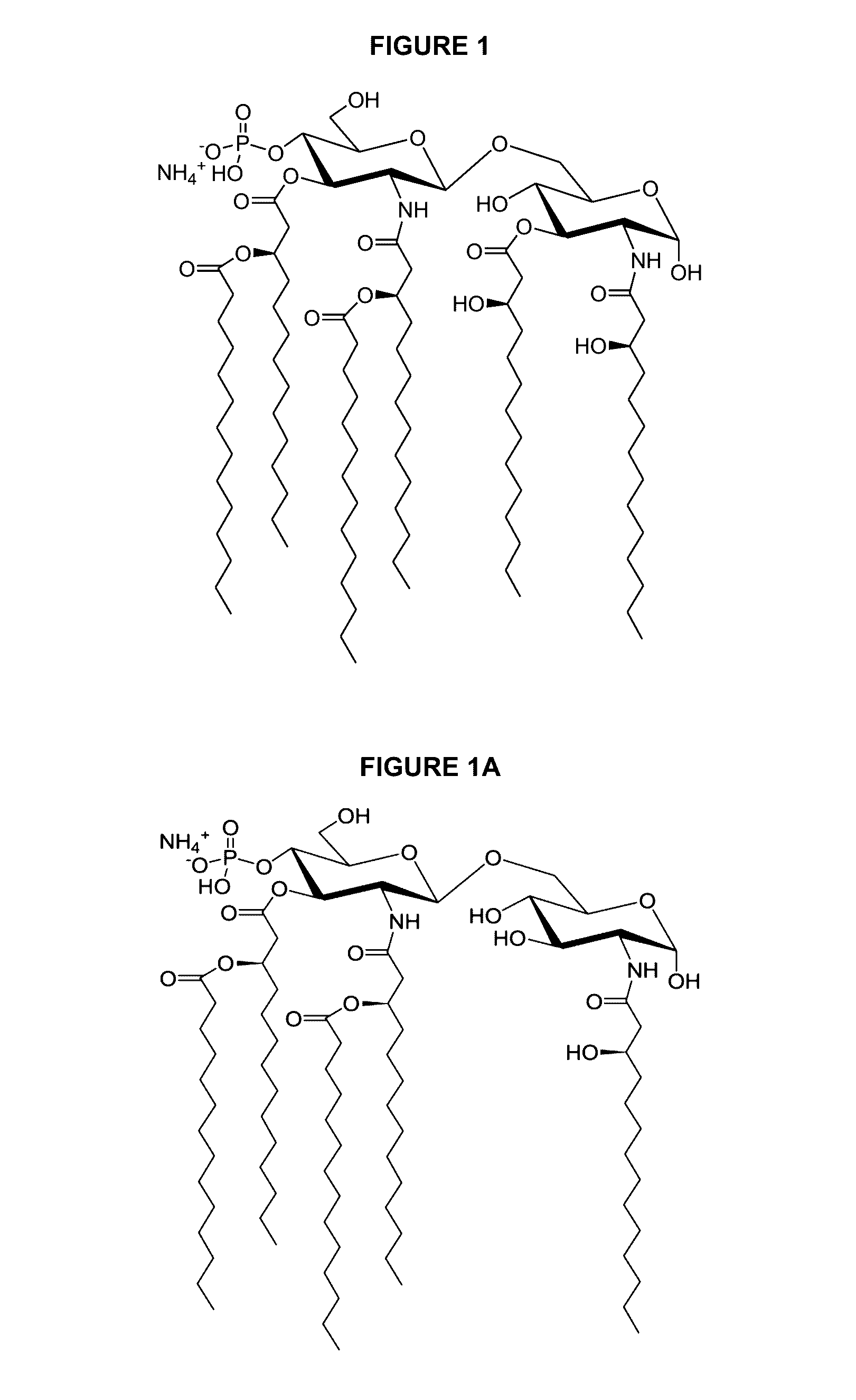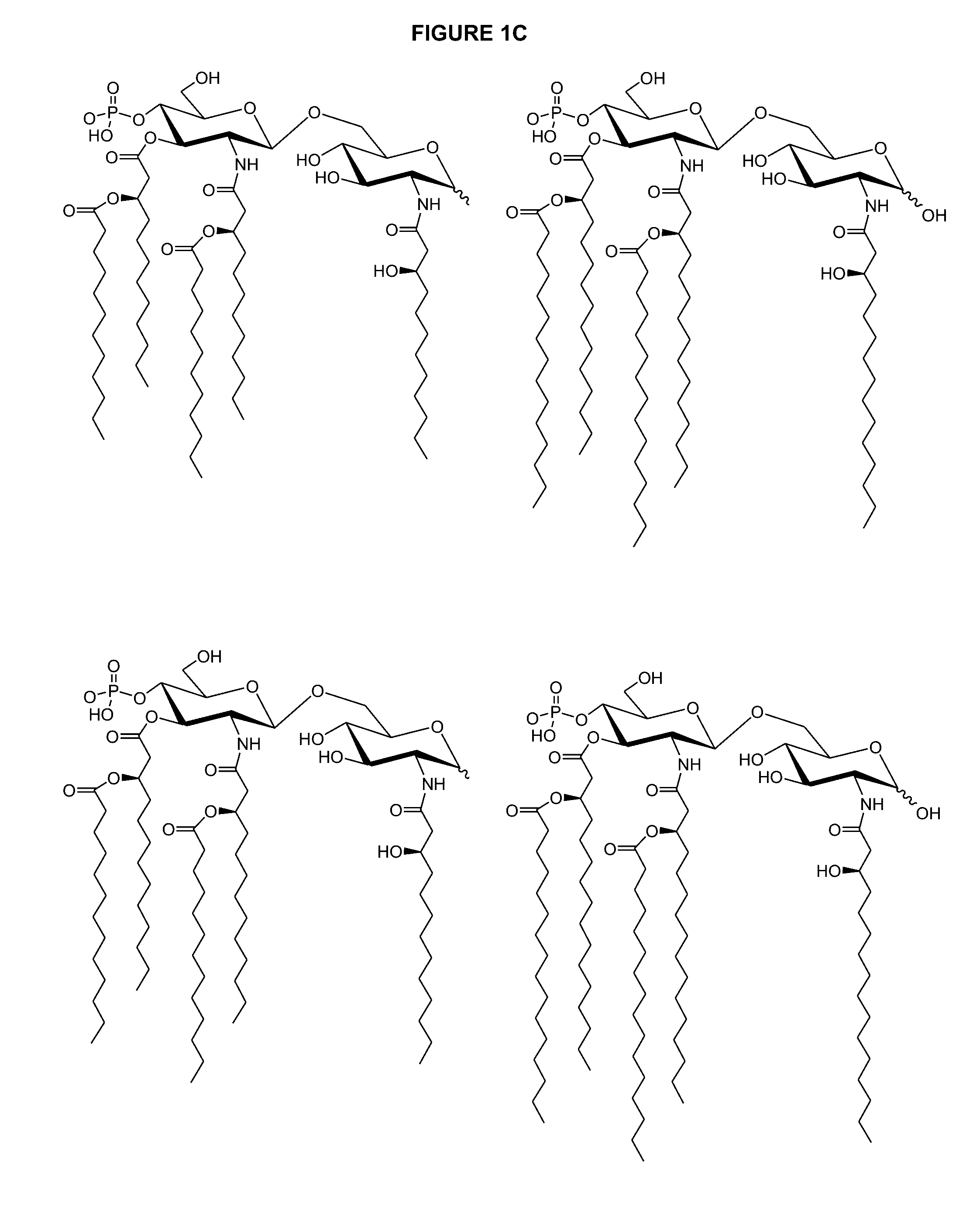Compositions of vaccines and adjuvants and methods for the treatment of urinary tract infections
a technology for enhancing the immune response of an antigen, a vaccine and adjuvant, applied in the direction of pharmaceutical delivery mechanism, inorganic non-active ingredients, antibody medical ingredients, etc., can solve the problems of reducing the effectiveness of swine flu vaccines, reducing the risk of infection, so as to improve the immune response to an antigen the effect of enhancing the immune respons
- Summary
- Abstract
- Description
- Claims
- Application Information
AI Technical Summary
Benefits of technology
Problems solved by technology
Method used
Image
Examples
example 1
[0246]Phosphorylated hexaacyl disaccharide formulations are manufactured as follows to produce a molar ratio of about 2.5:1 of DPPC to phosphorylated hexaacyl disaccharide.
[0247]PHAD Avanti Polar Lipids (Alabaster, Ala., USA), phosphorylated hexaacyl disaccharide, and DPPC can be obtained from Avanti Polar Lipids (Alabaster, Ala., USA) as either non-GMP or GMP material (the Certificate of Analysis is provided in Table 1). PHAD is a synthetic version of monophosphoryl lipid A. PHAD is formulated with DPPC to prepare the adjuvant formulation of the invention. DPPC's release specifications are provided in the table 2. The transition temperature of DPPC is 41° C.
[0248]PHAD is weighed out into an appropriate glass vial, preferably a Type 1 Plus Schott glass vial. An appropriate amount of an approximately 2.3 mg / ml DPPC solution, or equivalent, in ethanol is added. This preparation is sonicated for approximately 1 minute while gently swirling the preparation, and then the ethanol is appro...
example 2
[0255]Antigens for the vaccine may be prepared as follows.
[0256]FimCH is a non-covalent complex of FimC and FimH recombinant proteins. The recombinant proteins are derived from transgenic E. coli culture. The FimC and FimH proteins are expressed separately in E. coli, and they spontaneously form a non-covalent complex. The molecular weight of the FimCH complex is approximately 51,700 Daltons.
[0257]The FimH protein (SEQ ID No: 1) of the complex has a molecular weight of 29,065 Daltons, and it consists of 279 amino acid residues represented by the sequence below:
[0258]Phe Ala Cys Lys Thr Ala Asn Gly Thr Ala Ile Pro Ile Gly Gly Gly Ser Ala Asn Val Tyr Val Asn Leu Ala Pro Val Val Asn Val Gly Gln Asn Leu Val Val Asp Leu Ser Thr Gln Ile Phe Cys His Asn Asp Tyr Pro Glu Thr Ile Thr Asp Tyr Val Thr Leu Gln Arg Gly Ser Ala Tyr Gly Gly Val Leu Ser Asn Phe Ser Gly Thr Val Lys Tyr Ser Gly Ser Ser Tyr Pro Phe Pro Thr Thr Ser Glu Thr Pro Arg Val Val Tyr Asn Ser Arg Thr Asp Lys Pro Trp Pro Val Ala ...
example 3
[0264]Bioprocessing (Process to Obtain Antigens of the Vaccine)
[0265]The bioprocessing step is initiated with inoculation of master cell bank (MCB) into shake flasks containing APS LB medium with kanamycin (50 μg / mL) and chloramphenicol (20 μg / mL). When the OD reaches 2.0-3.0 units (after approximately 15 hours growth), the cell culture is transferred aseptically into reactors for fed-batch fermentation. The medium containing APS Super Broth, about 0.8% glycerol, and antibiotics is sterilized prior to inoculation. FimH protein expression is induced at OD 10 with IPTG. Five minutes after IPTG addition, FimC protein expression is induced with arabinose. Cells are harvested approximately one hour later. After harvesting, the cells are separated from the media components by continuous or batch centrifugation.
[0267]Recombinant FimCH is expressed in the E. coli periplasm. E. coli, as a gram negative bacteria, possess an inner and an outer lipid bilayer membrane. The ...
PUM
| Property | Measurement | Unit |
|---|---|---|
| temperature | aaaaa | aaaaa |
| mean particle size | aaaaa | aaaaa |
| molar ratio | aaaaa | aaaaa |
Abstract
Description
Claims
Application Information
 Login to View More
Login to View More - R&D
- Intellectual Property
- Life Sciences
- Materials
- Tech Scout
- Unparalleled Data Quality
- Higher Quality Content
- 60% Fewer Hallucinations
Browse by: Latest US Patents, China's latest patents, Technical Efficacy Thesaurus, Application Domain, Technology Topic, Popular Technical Reports.
© 2025 PatSnap. All rights reserved.Legal|Privacy policy|Modern Slavery Act Transparency Statement|Sitemap|About US| Contact US: help@patsnap.com



